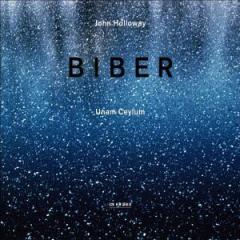Biber — Unam Ceylum (Violin Sonatas) [2002]
Biber — Unam Ceylum (Violin Sonatas) [2002]

1. Sonata III F major from Sonatae Violino solo 1681 2. Sonata IV D major from Sonatae Violino solo 1681 3. Sonata No. 81 A major – unpublished 4. Sonata VI C minor from Sonatae Violino solo 1681 5. Sonata VII G major from Sonatae Violino solo 1681 6. Sonata No. 84 E major: Adagio – unpublished John Holloway: violin Aloysia Assenbaum: organ Lars Ulrik Mortensen: harpsichord
Throughout his career, Biber composed and published liberally. He is best known for his violin compositions and was considered the finest violin virtuoso of the seventeenth century, his talent predating Niccolo Paganini’s by one hundred years. In the violin arena, Biber was especially known for writing pieces exploiting effects made possible through scordatura, or non-standard tuning of the violin, a method also favored by Paganini.
A good bit of Biber’s composition was devoted to violin sonatas with continuo (harpsichord or organ) accompaniment. His Mystery Sonatas, based on the three sets of divine mysteries of the Catholic Rosary, are his masterpieces but do not represent his total output. Biber wrote many fine violin sonatas, a series of which are performed here.
Violinist John Holloway has previously recorded the complete set of Biber's Mystery Sonatas (Virgin Classics Veritas, VCD7 59551-2, 1991), which were warmly received when released. On Unam Ceylum, Holloway explores four sonatas from Biber's set of 16 sonatas entitled Sonatae Violino solo 1681, plus two previously unpublished sonatas from approximately the same period. Several other versions of these pieces appear on record, including one by Monica Huggett of Sonatas 3 and 7 (ASV CD GAU203, 1991) and the complete reading by Andrew Manze with his trio Romanesca (Harmonia Mundi, 90 7134/5, 1995). These alternate recordings are not merely fine but are also Gramophone Award Winners as was Holloway’s Mystery offerings. This begs the question about the music that has inspired such accolades over the last decade.
Biber music was mostly cheerful and full of the baroque invention that made his contemporaries, as well as himself, famous. In Holloway’s hands, these sonatas reveal both their folk origins and reverential beginnings. This present ECM recording sounds like warm music played in a cold place. All of the intonation is concise and clear and the execution crystalline. The tone and mood of the music makes one think that this is what Keat’s Beadsman was listening to as he prayed in The Eve of St. Agnes. This music is at once pious and fertile, highlighting that constant struggle.
When performed capably, one cannot own too much of this music. Biber is well ignored by the majority of pedestrian classical listeners, a fact that must be reversed. John Holloway is addressing this fact directly with Unam Ceylum. This recording is beautiful in every way. And besides that, one can only hear so much Vivaldi anyway. --- C. Michael Bailey, allaboutjazz.com
download: uploaded anonfiles mega 4shared mixturecloud yandex mediafire ziddu
Zmieniony (Poniedziałek, 26 Sierpień 2013 14:42)








